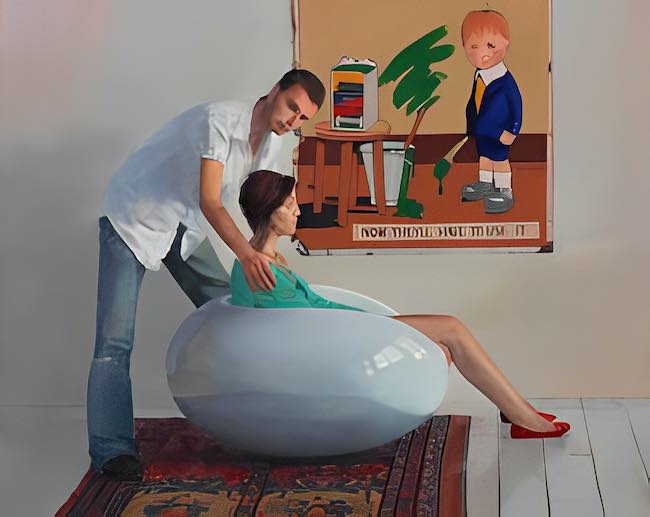L’arte attuale mostra la possibilità di potersi assecondare all’intento pittorico di ciascun creativo, soprattutto si amalgama, anche in virtù della conoscenza delle tecniche esecutive ed espressive del passato, alla singola sensibilità che diviene filtro tra ciò che l’osservatore vive nella sua quotidianità in maniera pressoché inconsapevole, e il punto di vista di chi, come l’artista, ha la capacità di soffermarsi sul dettaglio oppure di mostrare un aspetto della realtà spesso trascurato se non persino ignorato a causa dell’urgenza del vivere correndo dietro al pragmatismo degli obiettivi da raggiungere. Approcciare il presente attraverso tecniche e stili appartenenti al passato riesce a fondere ancor di più tutto ciò che è pittoricamente legato a un’espressività quasi accademica ponendo in evidenza le imperfezioni, le fragilità e le debolezze di un’esistenza in bilico, incerta ma fondamentalmente l’unica che sia possibile vivere. Il protagonista di oggi, attraverso il suo particolare linguaggio pittorico, riesce a evidenziare esattamente tutto ciò che contraddistingue la società moderna, i suoi paradigmi e le sue pittoresche caratteristiche.
A partire dai primi decenni del Ventesimo secolo, il mondo artistico cominciò a mostrare la necessità di andare più a fondo rispetto all’estetica equilibrata che aveva contraddistinto sia il Realismo dell’Ottocento, sia il rivoluzionario Impressionismo dove tuttavia l’attenzione nei confronti della bellezza e dell’armonia rappresentativa era ancora prioritaria; al contrario invece, l’unica voce fuori dal coro fu quella dell’Espressionismo dove gli appartenenti alla corrente si mostrarono disposti a rinunciare a tutti i canoni formalmente armonici pur di lasciar prevalere un mondo interiore troppo a lungo lasciato ai margini dell’arte. Eppure quei primordi di rottura con le regole e gli schemi accademici, che in quella fase dovevano necessariamente estremizzarsi per indurre il mondo culturale a prestare attenzione a un modo diverso di esprimersi, erano destinati a fare dei passi indietro, a tornare in qualche modo verso una figurazione più moderata senza però abbandonare il percorso di manifestazione dell’interiorità che doveva continuare a lasciar fluire la sua voce. Dunque l’evoluzione dell’Espressionismo che si cominciò a delineare con il Secessionismo Viennese, con le opere di Gustav Klimt fortemente legate in alcune parti alla figurazione rinascimentale e quelle di Egon Schiele invece più vicine alla gamma cromatica realistica seppur mantenendo tratti espressionisti, e che si ampliò con intenti esplorativi ed espressivi differenti nel Surrealismo dove la priorità più che all’emozione veniva data alla psiche e alle sue inquietudini inespresse e nascoste, seguì successivamente un percorso dove gli estremi dei due movimenti, quello assolutamente emozionale e quello esclusivamente psicologico si sarebbero fusi per giungere a una fase più esistenziale, più interiore ma al contempo volta a sottolineare le sensazioni dell’individuo. Da un lato la Scuola di Londra soprattutto con il percorso artistico di Lucian Freud e dall’altro il Realismo Americano con le solitudini e le atmosfere rarefatte di Edward Hopper, hanno dato un quadro emozionante e vivido sulle incertezze del vivere moderno, quell’essere oltre l’equilibrio estetico o l’apparenza del possedere tipico della media borghesia emergente che lasciava l’individuo completamente destabilizzato e in bilico sulla propria vita. Dunque in qualche modo l’approfondimento, l’emergere della sostanza rispetto alla forma erano diventate condizioni quasi imprescindibili di quella nuova generazione di artisti degli anni Cinquanta che segnarono un nuovo cammino nel mondo dell’arte della seconda metà del Novecento. È proprio su questo aspetto che si concentra il percorso artistico dell’artista israeliano David Amnon Ar che ha costantemente ricercato durante il suo periodo di formazione, un bilanciamento tra il classicismo del disegno e della tecnica pittorica e lo sguardo critico, a volte ironico e altre critico su tutte le frivolezze, le superficialità e le insicurezze dell’uomo moderno.
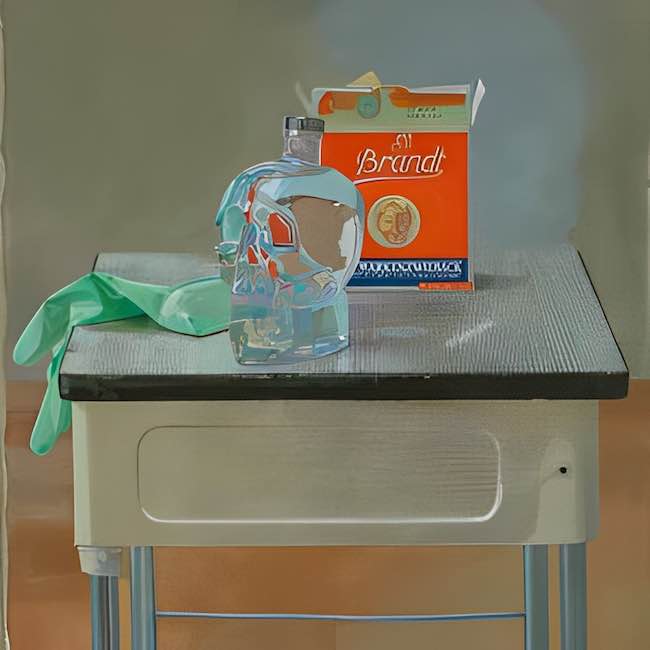
Studiando con i maestri più anziani non ha potuto fare a meno di apprezzare e consolidare la tecnica del disegno come base stessa della sua espressività pittorica, tanto quanto le velature e la luminosità delle sue atmosfere non possono non condurre la memoria verso la pittura rinascimentale da cui però si discosta per lasciare spazio a una forte e decisa impronta contemporanea, fatta di atmosfere nitide e di soggetti quasi sfocati, imperfetti proprio perché il suo sguardo tende a soffermarsi esattamente su tutto ciò che sfugge all’impeccabilità, a quei dettagli imprecisi che gli permettono di evidenziare il senso più ampio degli ambienti e dei frangenti immortalati.
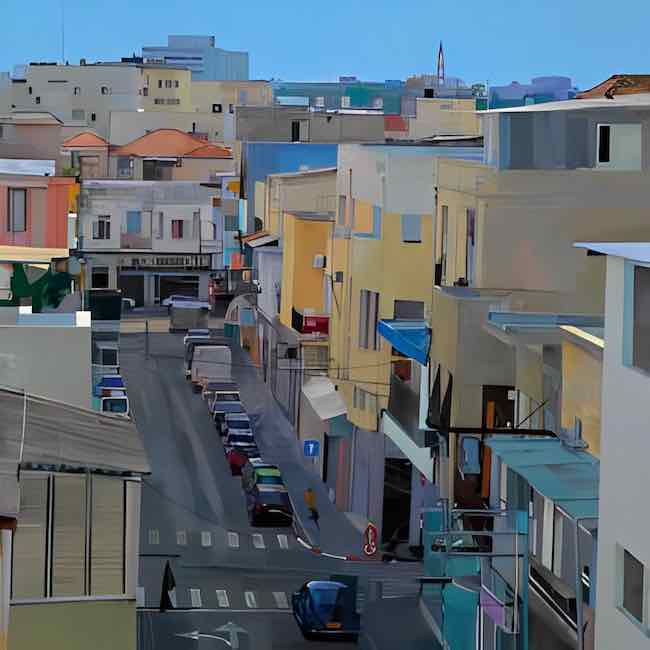
La luce è un elemento essenziale dei suoi dipinti, infonde un senso di purezza, di cristallizzazione delle emozioni, quasi a voler catalizzare l’attenzione dell’osservatore sul lato positivo, piacevole dell’esistenza per poi tendere, un attimo dopo, verso una profondità più esistenziale, domandandosi il motivo di quelle posizioni di riflessione, distanti quasi come se la mente dei protagonisti fosse concentrata su eventi e circostanze appena avvenuti oppure ancora da venire.

Pertanto David Amnon Ar sembra condurre lo sguardo verso un’interiorizzazione troppo spesso ignorata, ed è esattamente in virtù di quel suo trascurare i dettagli, i particolari del volto, la definizione della perfezione, che riesce a far emergere invece la sostanza, l’aspetto psicologico.
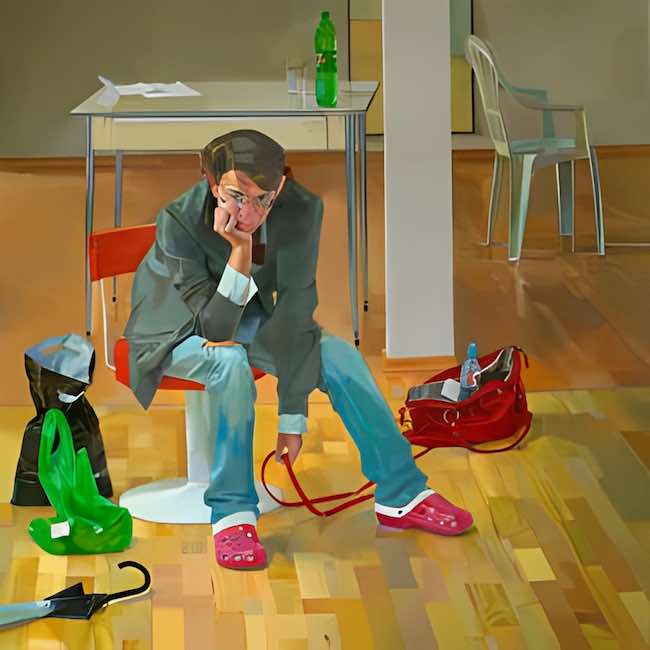
La tela Life itself (La vita stessa) racconta un frammento di riflessione dell’uomo sulla sedia, a metà tra l’icona più filosofica del Pensatore di Rodin e la materialità dell’individuo contemporaneo, circondato dagli oggetti che sembrano essere importanti, come una borsa che contiene i suoi averi, le buste in cui sono riposti gli acquisti appena effettuati, il tavolo e la sedia dell’appartamento all’interno del quale ha creduto di potersi rifugiare, eppure non può non meditare sulla sua solitudine, quel suo essere lì, in mezzo alla stanza che cerca di riempire di cose forse perché ciò che manca davvero è avere accanto qualcuno.
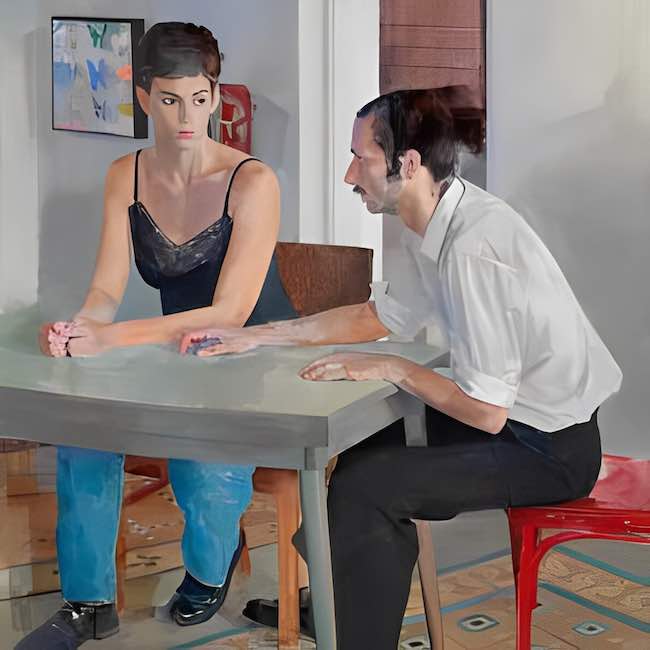
Nell’opera Untitled 2021 al contrario David Amnon Ar rende protagonista una coppia che sembra essere sul punto di prendere una decisione, oppure in procinto di aprire un dialogo reso difficile dall’incomunicabilità che assale spesso l’uomo moderno, troppo concentrato sul proprio individualismo, sui propri obiettivi e sui propri egoismi per essere in grado di interfacciarsi persino con la persona scelta, quella con cui dovrebbe essere facile e piacevole condividere pensieri ed emozioni. Questo dipinto infonde la sensazione di essere un fermo immagine, uno scatto di quel frammento di vita reale in grado di cambiare tutta la realtà, di scardinare ogni certezza e di essere il punto di arrivo di un rapporto o il momento dopo il quale tutto dovrà ricominciare.
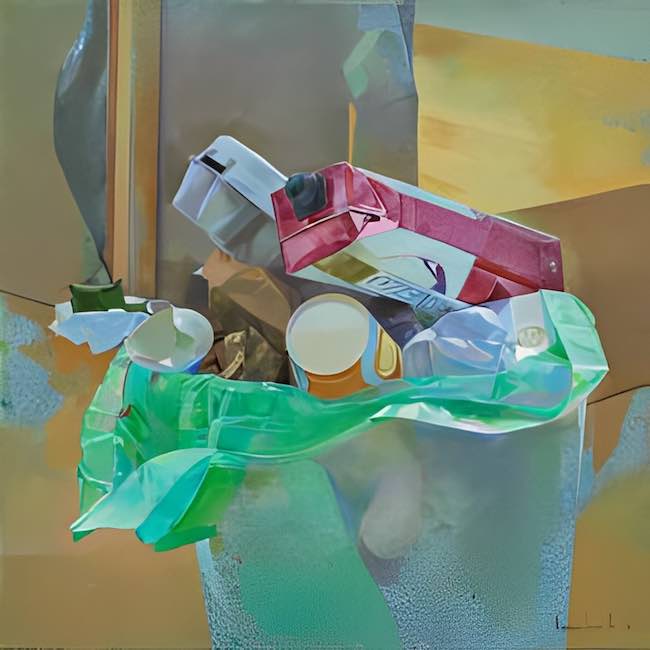
Lo sguardo dell’artista però è anche ironico sulle piccole debolezze dell’individuo moderno, quella tendenza all’accumulo nata con il consumismo degli anni Cinquanta e poi evoluto in una cultura del possedere e poi abbandonare, come se il vero fulcro dell’interesse fosse quello di sapere di poter avere, acquistare qualcosa; è questa la direzione che ha preso la società globale, ed è quanto emerge dal dipinto A bouquet dove l’appellativo che abitualmente si dà a un mazzo di fiori viene invece attribuito a un cestino della spazzatura dove protagonisti sono cartoni di vino, lattine, confezioni di uova, gettati e lasciati lì a terminare il loro utilizzo pur essendo però l’unico elemento a testimoniare la vita che si è svolta intorno fino a un attimo prima; metaforicamente quest’opera racconta l’approccio dell’essere umano attuale anche ai rapporti interpersonali che spesso diventano solo mezzo per soddisfare i propri bisogni, le proprie necessità e poi vengono messi in secondo piano da altro di più appetibile solo perché non conosciuto.
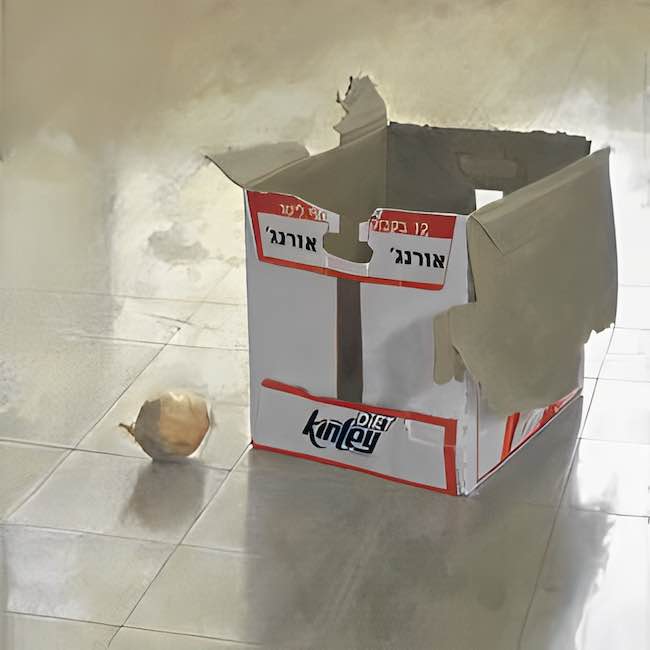
È sagace l’analisi di David Amnon Ar sull’esistenza contemporanea, acuto e attento ma tuttavia non gridato, piuttosto sussurrato, appena accennato perché preferisce lasciar trarre all’osservatore le proprie considerazioni rispetto agli episodi e ai frammenti di esistenza che di volta in volta vengono messe in luce nelle sue tele. David Amnon Ar si è formato in parte come autodidatta, nel senso che ha preferito esplorare e trovare in autonomia il proprio linguaggio espressivo distaccandosi dagli insegnamenti accademici, è stato illustratore e caricaturista e attualmente insegna pittura e disegno a Berlino, la città dove vive ormai da molti anni; ha al suo attivo numerose mostre personali e collettive e ha vinto primo premio 2020 del concorso SeeMee in Transition International New York, USA.
DAVID AMNON AR-CONTATTI
Email: memeshifman@gmail.com
Sito web: https://www.amnondavidar.com/
Facebook: https://www.facebook.com/amnon.ar
Instagram: https://www.instagram.com/amnondavidar/
The exaltation of contemporary imperfections in the Realism of David Amnon Ar
Today’s art shows the possibility of being able to indulge in the pictorial intent of each creative artist, above all by virtue of the knowledge of past techniques of execution and expression, to the individual sensibility that becomes a filter between what the observer experiences in his everyday life in an almost unconscious manner, and the point of view of one who, like the artist, has the ability to dwell on detail or to show an aspect of reality that is often overlooked if not even ignored due to the urgency of life running after the pragmatism of the goals to be achieved. Approaching the present through techniques and styles belonging to the past succeeds in merging even more everything that is pictorially linked to an almost academic expressiveness, highlighting the imperfections, frailties and weaknesses of an existence in the balance, uncertain but fundamentally the only one possible to live. Through his particular pictorial language, he manages to highlight exactly everything that characterises modern society, its paradigms and picturesque features.
Starting in the first decades of the 20th century, the artistic world began to show the need to go deeper than the balanced aesthetics that had characterised both 19th century Realism and the revolutionary Impressionism where, however, the focus on beauty and representational harmony was still a priority; on the contrary, the only voice out of the chorus was that of Expressionism where members of the current showed themselves willing to renounce all formally harmonious canons in order to let an inner world, too long left on the margins of art, prevail. Yet those beginnings of breaking with the rules and academic schemes, which at that stage necessarily had to become extreme in order to induce the cultural world to pay attention to a different way of expressing itself, were destined to take steps backwards, to return in some way towards a more moderate figuration without however abandoning the path of manifestation of interiority that had to continue to let its voice flow. Thus the evolution of Expressionism that began to take shape with Viennese Secessionism, with the artworks of Gustav Klimt strongly linked in some parts to classic figuration and those of Egon Schiele instead closer to the realistic colour range while retaining expressionist traits, and broadened with different exploratory and expressive intentions in Surrealism where priority was given to the psyche and its unexpressed and hidden anxieties rather than to emotion, then followed a path where the extremes of the two movements, the absolutely emotional and the exclusively psychological would merge to reach a more existential phase, more interior but at the same time aimed at emphasising the feelings of the individual.
On the one hand, the London School, especially with the artistic journey of Lucian Freud, and on the other hand, American Realism with the solitudes and rarefied atmospheres of Edwar Hopper, gave an exciting and vivid picture of the uncertainties of modern living, that being beyond the aesthetic balance or appearance of possession typical of the emerging middle class that left the individual completely destabilised and poised about his life. So in some way the deepening, the emergence of substance over form had become almost indispensable conditions of that new generation of artists of the 1950s that marked a new path in the art world of the second half of the 20th century. It is precisely on this aspect that focuses the artistic career of the Israeli artist David Amnon Ar who, during his training period, constantly sought a balance between the classicism of drawing and painting technique and the sometimes ironic and sometimes critical look at all the frivolities, superficialities and insecurities of modern man. Studying with the older masters, he could not help but appreciate and consolidate drawing technique as the very basis of his pictorial expressiveness, just as the veiling and luminosity of his atmospheres cannot fail to lead the memory back to Renaissance painting from which, however, he departs to make room for a strong and decisive contemporary imprint, made up of sharp atmospheres and almost out-of-focus subjects, imperfect precisely because his gaze tends to dwell precisely on everything that escapes impeccability, on those imprecise details that allow him to highlight the broader sense of the environments and the moments immortalised. Light is an essential element of his paintings, it infuses a sense of purity, of crystallisation of emotions, almost as if to catalyse the observer’s attention on the positive, pleasant side of existence, only to tend, a moment later, towards a more existential depth, wondering why those positions of reflection are so distant, almost as if the protagonists’ minds were focused on events and circumstances that have just happened or are yet to come. Thus, David Amnon Ar seems to lead the gaze towards an interiorisation that is too often ignored, and it is precisely by virtue of that neglect of particulars, facial details, the definition of perfection, that he manages to bring out the substance instead, the psychological aspect.
The canvas Life itself recounts a fragment of reflection of the man in the chair, somewhere between the more philosophical icon of Rodin’s Thinker and the materiality of the contemporary individual, surrounded by the objects that seem to be important, such as a bag containing his possessions, the envelopes in which the purchases he has just made are placed, the table and chair of the flat in which he believed he could take refuge, and yet he cannot help but meditate on his loneliness, his being there, in the middle of the room that he tries to fill with things, perhaps because what is really missing is having someone beside him. In the work Untitled 2021, on the contrary, David Amnon Ar portrays a couple that seems to be on the verge of making a decision, or about to open a dialogue made difficult by the incommunicability that often assails modern man, too focused on his own individualism, his own goals and his own selfishness to be able to interface even with the person of his choice, the one with whom it should be easy and pleasant to share thoughts and emotions. This painting infuses the sensation of being a still image, a snapshot of that fragment of real life capable of changing all reality, of unhinging all certainty and of being the point of arrival of a relationship or the moment after which everything will have to begin again. The artist’s gaze, however, is also ironic on the small weaknesses of the modern individual, that tendency towards accumulation born with the consumerism of the 1950s and then evolving into a culture of possessing and then abandoning, as if the real focus of interest were to know that one can have, to buy something; this is the direction that global society has taken, and this is what emerges from the painting A bouquet, where the appellation usually given to a bouquet of flowers is instead attributed to a rubbish bin where the protagonists are wine cartons, cans, egg cartons, thrown away and left there to finish their use, even though they are the only element bearing witness to the life that took place around them until a moment before; metaphorically, this artwork recounts the approach of today’s human being to interpersonal relationships, which often become merely a means of satisfying one’s own needs, one’s own necessities, and are then overshadowed by something else that is more palatable just because it is unknown. David Amnon Ar’s analysis of contemporary existence is shrewd and attentive but nevertheless not shouted out, rather whispered, barely hinted at because he prefers to let the observer draw his own considerations regarding the episodes and fragments of existence that from time to time are brought to light in his paintings. David Amnon Ar trained partly as a self-taught artist, in the sense that he preferred to explore and find his own expressive language on his own, detaching himself from academic teachings. He has been an illustrator and caricaturist and currently teaches painting and drawing in Berlin, the city where he has been living for many years; has numerous solo and group exhibitions to his credit and won first prize 2020 in the SeeMee in Transition International competition New York, USA.


